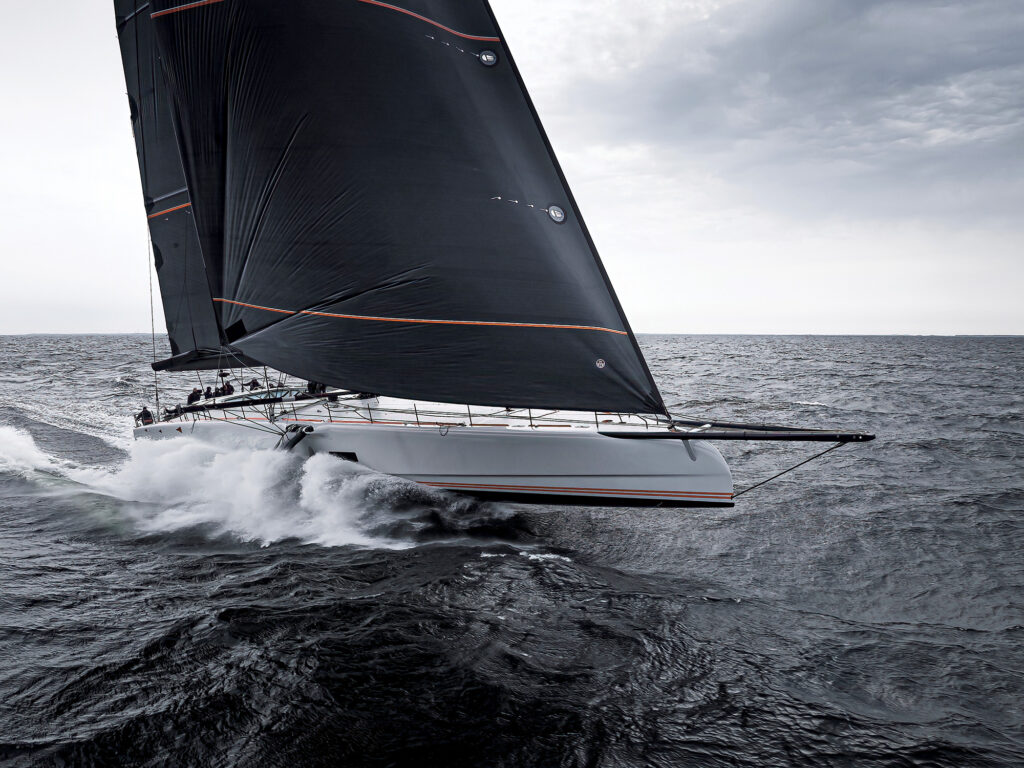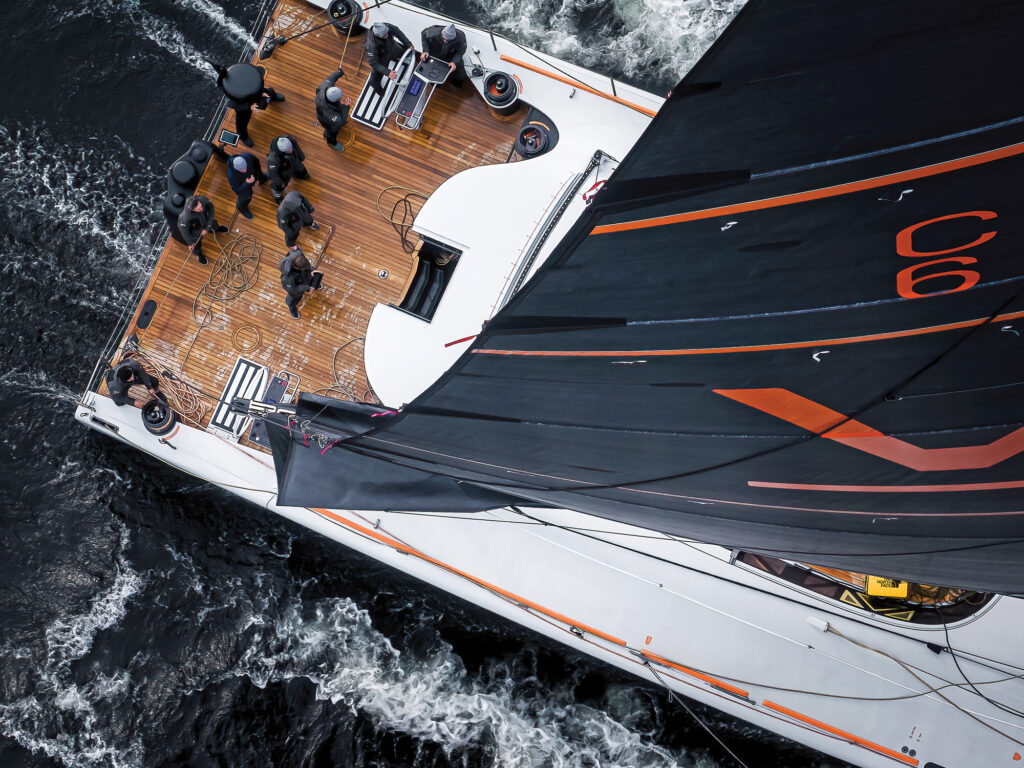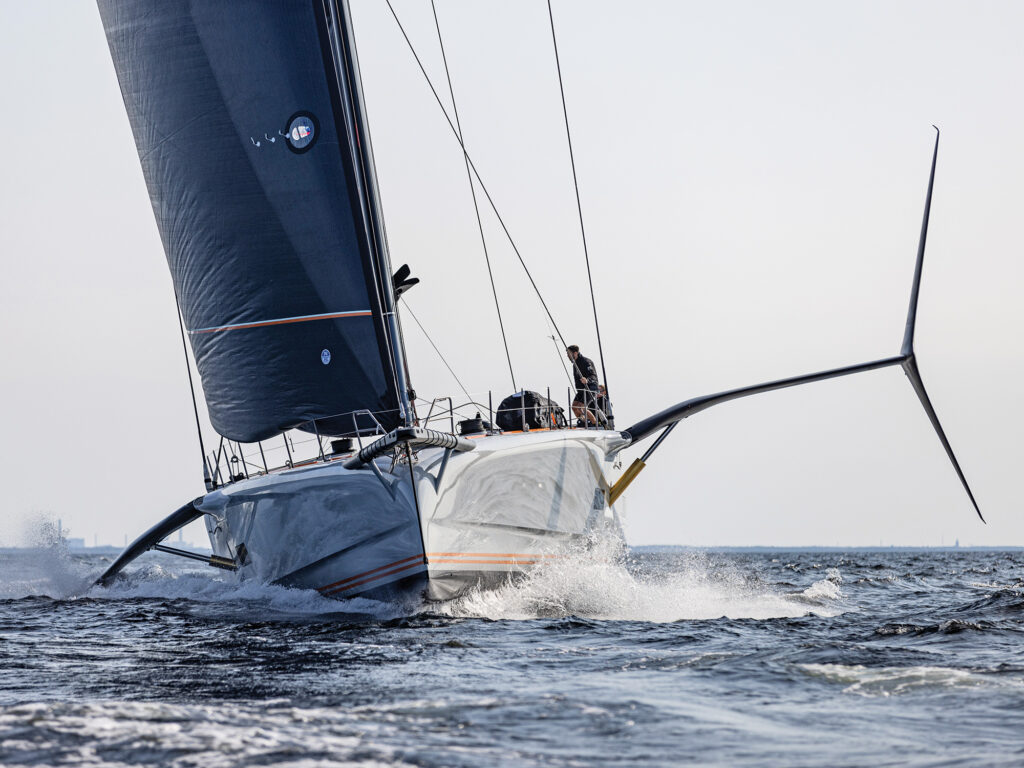
For those who appreciate waterborne technological marvels, the details that slowly emerged from Baltic Yachts of a top-secret project—what appeared to be a 111-foot-long fully foiling race boat—had us salivating. Would it be like Roberto Lacorte’s foiling Flying Nikka but twice the size? How many race line honors and records might it scoop up? What kind of daily mileage might such a beast achieve? All good questions, with answers to come in due time. The extraordinary all-carbon Raven certainly has its race boat traits: an AC75 foil configuration, sleek lines from Finnish stylist Jarkko Jämsen and naval architects Botin Partners, and a high-caliber crew, but those behind the project say that it is not a race boat. They prefer “the ultimate performance superyacht.”
Since the beginnings of yachting, there have been all manner of yachts that might have been described this way, from the early America’s Cup challengers and J Class, Robert Miller’s Mari Cha III and IV to Gianni Agnelli’s Extra Beat and the more recent supermaxis like the ClubSwan 125 Skorpios, or even the 219-foot ketch Hetairos, to name but a few. Yet none before Raven have ever combined such extreme performance hand-in-hand with this much style and luxury. With the high-end composite-work and fit-out that one would expect from Baltic Yachts, Raven truly sets a new benchmark for fast superyachts. As Raven’s owner says: “We just wanted to do a superyacht, but a fast one with foils; to try to do something different; and with an interior that you can sit inside, and is comfortable and nice.”
While Raven does have a similar articulating foil arrangement to the AC75s, the boat is not designed to fully break free of the surface. Instead, like IMOCAs, its optimal sailing condition is “skimming mode.” Its giant foils are designed to reduce its displacement by up to 40 or 50 percent. As Raven’s sailing team manager Claes “Klabbe” Nylöf explains: “It is a displacement boat with the asset of having the foils. The foils are like a turbo boost.”
Similar to Lacorte’s 60-foot racing foiler, Flying Nikka, Raven also has a modest fixed keel, albeit with a groundbreaking carbon-fiber foil, so, unlike AC75s, its lifting foils are not additionally ballasted. Rather than elevators on the twin rudders, interceptors fitted on the transom provide fore and aft trim. For those unfamiliar with these, they are essentially powerboat technology comprising a large plate (or several plates, in Raven’s case) that can be lowered by 30 to 50 mm. At speed, these generate lift at the transom, pushing the bow down. They are rare, but not unique, in the sailing world. For example, a single large interceptor plate was fitted to Mike Golding’s Ecover 3 IMOCA 60 for the 2008 Vendée Globe.

Yacht-racing pundits took one look at the first photos of Raven and assumed it would be gunning for line honors in the major offshore races or attempting to break records. But neither is true—in the short term, at least. Raven’s owner already has an impressive fleet, spanning a 414-foot Lurssen superyacht down to a ClubSwan 36 that he enjoys sailing doublehanded in his native Sweden. In between, Raven’s intended present use is as a daysailer. The owner very much enjoys sailing his mighty boat at blistering speeds, but as important to him is Raven’s ability to stop somewhere nice where he can relax and enjoy life on board. He also enjoys being involved in the innovation that Jämsen, Botin Partners, he and the team have incorporated into their 111-foot skimming masterpiece.
One of Raven’s most interesting technical aspects is its structure and the vital figure of its maximum dynamic righting moment, as decided between Botin Partners, Southern Spars, and Pure Design & Engineering. To give some idea of the numbers involved with Raven, its righting moment with water ballast only and no foils is 100 tons per meter, and with foils and no ballast it’s 180 tons per meter. The issue with Raven is that it is oh so tempting, and so easily possible, to exceed limitations, at which point the weakest link will be found and extreme catastrophe could well result. Naturally, there are all manner of alarms to warn of this, at which point Raven is depowered simply by dumping the mainsail. This predicament has been known and considered on superyachts and especially large racing multihulls for decades, requiring a sympathetic approach to how they are sailed, so it is fortunate that Nylöf has previously skippered ORMA 60 trimarans, while Raven’s hugely experienced French captain, Damien Durchon, has also been captain on Comanche and a regular hand on both Mari Cha III and IV as well as Hetairos.
While it is tempting to think speed, speed, speed with Raven, comfort is also important to the owner—not just when moored, but underway too. Fully foiling racing boats, with their massive accelerations and decelerations, are among sailing’s least comfortable yachts, requiring crews to don crash helmets and body armor. This is not the case on board Raven. Due to its weight and inertia, it has moderate acceleration and only ever sails in displacement or semidisplacement modes. Water ballast provides righting moment upwind and, when down-speed, the foils provide minimal lift, and they also can be used to stabilize the boat in rough conditions. Off the breeze at speed when the foils are operating, they have the effect of locking the boat to the water, reducing pitching and heeling. The flaps on each foil can also be used as lateral trim tabs to dial in more lift to leeward, thereby reducing heel from, for example, 25 to 5 degrees, again improving comfort. However, this also encourages bow-down trim, which in turn can be countered by adding water ballast or increasing lift from the interceptors. Figuring out how best to combine all these variables (not to mention the rig setup and sail combinations) for differing wind conditions and sea states is an ongoing project, with the aim of automating many. This would enable Raven to be sailed with reduced crew for cruising and deliveries (from the 16 crew that Durchon expects will be their typical number when sailing properly).

As ever with large, fast boats, peak speeds are of little interest (especially because they would involve exceeding structural limits). However, high average speeds are desirable. Raven is already sitting on speeds of 25 to 27 knots and has topped 30 knots. Once fully optimized, in the right conditions, 600-plus miles per day is realistic, making it one of the world’s fastest offshore monohulls, and certainly the fastest on which there is a fully stocked bar, a washing machine and so much more.
At the opposite end of the spectrum, speed in light winds has also been considered. Botin Partners’ Adolfo Carrau says that in the light, both foils can be raised. It will be rare not to have one deployed, and in this configuration, Raven benefits from a narrow waterline hull with a chine that causes it to rapidly gain stability when heeled.
The boat’s light weight is vital to reaching optimal skimming state in the least amount of wind, and while Raven has amenities from air conditioning to a fully fitted-out galley, Jämsen’s interior is otherwise supremely light in order to achieve an overall displacement of roughly 50 tons (i.e., only marginally more than the 100-foot nonfoiling Leopard 3 and Wally Cento superyachts). In achieving this, Jämsen has been highly creative. For example, composite decking, as you might find on a TP52 cockpit sole, is used below—not just on the floor, but also as a wall covering. There is much use of rattan-covered carbon-fiber frames for ceiling panels, while Jämsen has not feared making features of the tech. For example, two hydraulic rams operating rig functions are located on either side of the washbasin in a guest cabin.
On deck, Raven has twin cockpits—the working cockpit aft for the crew, including twin steering positions, while forward is a giant guest cockpit. Here there is yet another of Raven’s great features: The guest cockpit is open to the elements, but if it starts getting wet, the cockpit’s entire aft half folds up and over, dropping down over the cockpit’s forward half to form a large doghouse.









